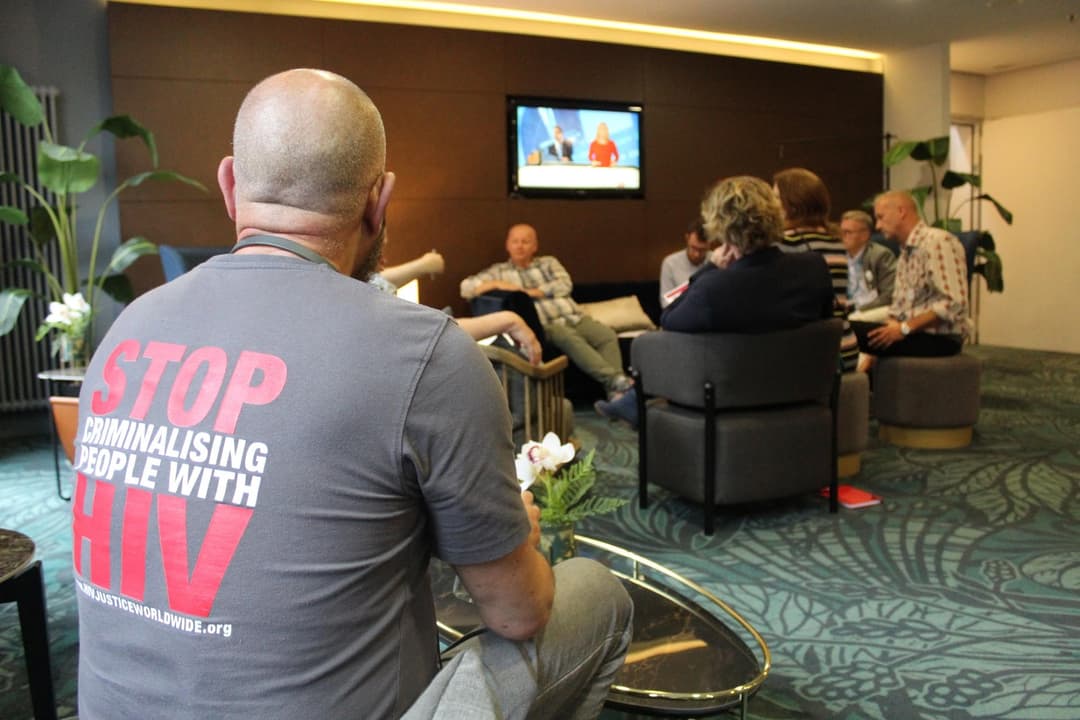Criminalisation of HIV non-disclosure, exposure and transmission – one could think that this is not an issue anymore. The contrary is true: It is a growing phenomenon in our region that has direct and deep impact on human rights. This is why the AIDS Action Europe Steering Committee decided to take the topic up in its 2019 Member and Partner Meeting and combine it with partner notification and the impact criminalisation has on partner notification. The meeting took place in Berlin on Saturday, October 19 and was attended by 41 participants representing member and partner organisations from 23 countries from the WHO European Region.
Edwin Bernard, the executive co-ordinator of HIV Justice Network, was invited to make a keynote introduction on the topic of HIV criminalisation. HIV criminalisation often targets the most marginalised (migrants, sex workers, people who use drugs) and reinforces stigma that prevents people from getting tested, learning their status, accessing prevention and/or treatment.
Science against criminalisation of PLHIV
In the WHO European region, it is the EECA region where there areHIV-specific criminal laws. They are often overly broad and do not take into account current scientific developments of HIV, such as TasP or U=U.
The European cases outside of EECA happen under general criminal laws (e.g. bodily harm, endangerment, public health). They usually increase stigma by picking out HIV and can be applied to situations where there was no risk of HIV transmission and can lead to disproportionately long sentencing compared to other harms prosecuted under the same laws.
Most cases involve not disclosure of HIV status, a person living with HIV is assumed not to have informed their partner about their HIV status before having sex. Many cases involve perceived exposure, meaning no HIV transmission took place and the risk of transmission was low or non-existing (low viral load, the condom was used, also cases of spitting or biting). They also involve faulty assumptions of guilt where transmission is alleged (e.g. first diagnosed in a couple is often considered first infected, phylogenetic tests are rarely used and their results can easily be misinterpreted).
Limited understanding of current HIV science reinforces stigma and may lead to harm PLHIV
In July 2018 during the International AIDS Conference, an Expert Consensus Statement on the science of HIV in the context of criminal law was published. The statement that was written by a global panel of leading scientist, stating that there is no scientific evidence that would support criminalisation of HIV.
Following the discussion, Ferenc Bagyinszky, AAE project manager, presented the work of the European HIV Legal Forum on HIV criminalisation (EHLF). The mission of EHLF is to develop effective means of improving access to HIV services for all those who have limited access to HIV services due to legal obstacles. Calum Douglas, Policy & Campaigns Officer of National AIDS Trust, UK, as a member of the European HIV Legal Forum, presented their work on the development of guidelines for prosecutor and police in England and Wales.
One result of the EHLF activities is that working with media is very important for the organisations to deal with criminalisation cases in the country. A working group session during the meeting was designed to discuss specific cases and how working with media could be approached. Learn more about work of the EHLF on HIV criminalisation here.
Partner notification only on voluntary basis with supportive social and legal environments for disclosure
The last part of the meeting focused on partner notification and its potential impact on HIV criminalisation. Partner notification, also known as active case finding or contact tracing, is a process whereby sexual partners of patients given an HIV/STI diagnosis are informed of their exposure to infection and the need to receive a test and possible treatment.
In the European context, approach to partner notification differs from country to country and is influenced by different backgrounds, cultures and history. Additionally, due to the 90-90-90 targets there is an increased push for partner notification and its perceived public health goal to find new infections.
During the discussion, it became clear how different the approaches within Europe to partner notification are. As was presented by Sini Pasanen, chair of the AAE Steering Committee and HIV Nordic, partner notification is widely used in the Nordic countries and it can be done either by the patient themselves or by the clinic or doctors.
Lella Cosmaro, LILA Milano, Italy, presented the work of the Joint Action Integrate (on integrating prevention, testing and linkage to care strategies across HIV, viral hepatitis, TB and STIs in Europe) where they are developing an ICT tool with the aim to make PN easier for those who cannot or would not feel safe to do it themselves.
Everyone agreed with the recommendations of the World Health Organization (WHO) and the Joint United Nations Programme on HIV/AIDS (UNAIDS) that partner notification should be done only on a voluntary basis within enabling and supportive social and legal environments for disclosure.
However, one argument against non-anonymous partner notification is HIV criminalisation, which already has bad practice, for instance in Belarus.
PRESENTATIONS AT THE MEMBER AND PARTNER MEETING 2019
- HIV Criminalisation in the WHO European region and around the world
by HIV Justice Network- The European HIV Legal Forum – Criminalization of HIV-transmission, exposure and non-disclosure
by AIDS Action Europe- Criminalisation in England and Wales: Guidelines for Police and Prosecutors
by National AIDS Trust, UK- Working with the media on HIV criminalisation
by HIV Justice Network- Partner Notification and Criminalisation
by AIDS Action Europe- HIV and the Criminal Code in the Nordic Countries
by HIV Nordic- Integrate and Partner Notification
LILA Milano, ItalyALL PHOTOS OF THE MEMBER AND PARTNER MEETING 2019, PLEASE CLICK HERE


